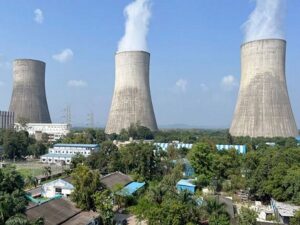GS3 – Environment

Context
Union Budget 2025–26 sets a target of 100 GW nuclear power capacity by 2047, up from 8.18 GW currently.
Overview of Nuclear Energy
Process:
- Generated through nuclear fission (splitting of atomic nuclei).
- Heat from fission produces steam → drives turbines (similar to thermal plants but without fossil fuels).
Significance of Nuclear Power
Meeting Energy Demand:
- India’s electricity demand expected to increase 5x by 2047.
- Nuclear power offers stable base-load supply.
Climate Commitments:
India’s COP26 Goals:
- 500 GW non-fossil fuel capacity by 2030.
- Net-zero emissions by 2070.
- Nuclear is low-carbon and aligns with these targets.
Energy Security:
High load factors and reliability strengthen India’s energy mix.
Global Support:
COP28 Declaration calls for tripling nuclear energy, especially in developing nations.
Key Challenges in Expansion
Policy Barriers:
- Atomic Energy Act, 1962 limits power generation to government (NPCIL).
- Legal uncertainty on ownership, tariffs, waste disposal.
- No private sector participation.
Financial Limitations:
- Capital intensive: ~$2 million/MW.
- Not classified as “renewable” → lacks access to green finance.
Regulatory Concerns:
AERB lacks legal independence (under DAE).
Operational Bottlenecks:
Delays in land acquisition, licensing, and supply chains.
Three-Pronged Reform Strategy
- Legislative Reforms
- Amend Atomic Energy Act, 1962:
- Allow private participation with up to 49% FDI.
Amend CLNDA, 2010:
Ease supplier liability clauses to attract foreign tech.
- Regulatory Reforms
- Create a statutory independent regulator to replace AERB.
- Align Atomic Energy Act and Electricity Act, 2003.
- Adopt levelised cost-based tariff models.
- Financial and Institutional Reforms
- Reclassify nuclear as green energy:
- Eligible for tax incentives, VGF, and green bonds.
- Promote long-term PPAs.
- Form joint ventures with PSUs (e.g., NTPC, REC).
- Open sector to trustworthy private players.




